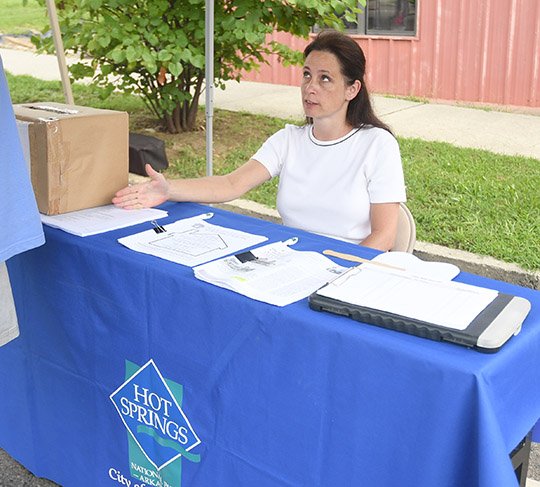The wandering spirit has beckoned again for Michelle Sestili, who is moving to Houston with her husband, Max, but as the saying goes, she is leaving Hot Springs a better place than she found it.
Sestili has served as the city's Community Development Block Grant administrator since 2013, and since then has overseen and pushed through almost $2 million in improvements to infrastructure, neighborhood revitalization, economic development, increases in affordable housing and compliance with federal regulations.
Sestili, whose last day on the job was Friday, started the position on April 1, 2013, and jokes, "this has been the longest running April Fool's gag ever." She and her husband moved to Hot Springs from Orlando, Fla., almost 12 years ago, which she said is the longest she has lived anywhere.
"I used to move every six months to two years. That says a lot about the people of Hot Springs that we stayed so long. I just love the town," she said, noting they plan to keep the "dream house" they built in the county and rent it out.
Right from the beginning, Sestili changed things by letting the citizens decide where to spend the CDBG funding. "Our program is pretty unique in that we solicit applications from the community," she said. "Most cities don't do that. In most cities the cities choose the projects. Period. We work it from a grass roots standpoint.
"Neighborhoods are all different. I love working with them. They brainstorm their own ideas and then come to me to ask if its eligible. Then they work with the city department that applies, which may be engineering, or parks or transit or stormwater or public works. They work with them to see what's feasible.
"What sometimes comes out of that is the city may be thinking about doing a project on that street, too, and they can combine the two together and get something really cool out of it."
The result has been infrastructure improvements to five neighborhoods, including Whittington Avenue, Park Avenue, the Gateway Community, Albert Pike "a tiny bit where it's eligible," and the area around Oaklawn Park. They also worked on the Forest Hills neighborhood through their support of Habitat for Humanity.
When it comes to CDBG grant regulations, Sestili said, "the crazy thing is we can't buy a two-by-four to build a house, so that's why we support Habitat." CDBG money can fund the lot acquisitions, surveys, sidewalks and sewer extensions, "which are really expensive."
On Garden Street, Habitat built four new houses and CDBG funds paid for the sewer extension. "It was very expensive because of the conditions under the street there, like $40,000. So each of those houses without CDBG help would have cost $10,000 more. Folks getting those mortgages can't afford $10,000 more. It's a deal breaker."
More than 7 miles of sidewalks have been reconstructed to American with Disabilities Act accessibility standards in the last four years with CDBG funding.
"There will be a telephone pole in the middle of a sidewalk or a retaining wall that leaves no room between the wall and curb. It's always interesting to just walk the sidewalks from the perspective of, 'What if I was in a wheelchair?' Engineers are real good at looking at that. Motorized wheelchairs have a lip on the front where even a little upheaval in the sidewalk will catch on it. It takes a trained eye."
She said they try to connect areas with elderly and disabled residents to decent sidewalks that already exist, which involved work on Park Avenue, and in the Gateway Community on Pleasant, Crescent, Silver, Wade and Vine streets. "That connected people all the way so you could roll from Park Avenue to Wade Street Park if you needed to."
Sestili said there is "anecdotal evidence it helps with economic development. Once there are areas where we invested in sidewalks, businesses started coming around that weren't there before." Citing the planned Malvern Avenue revitalization project, she noted, "Buildings are being sold off Malvern that were vacant for a very long time."
She said there are also entire households with no access to a motor vehicle. "It's about 25 percent in the Whittington area and in the teens in the Park and Gateway areas," she said. "So getting people around on foot and making them comfortable waiting for a bus continues to come up in public outreach and surveys as a priority."
Four ADA-accessible bus shelters have been installed. "People go nuts for bus shelters. It shows how small investments can make a big difference," she said. Three more are planned at Ouachita Children's Center on Charteroak, on Highrise Circle and on Whittington Avenue past the Weyerhaeuser offices.
"That shelter was actually a recommendation from Intracity Transit. There is a big apartment complex there, a trailer park and people getting off for Baseball Trail Park. It's a really busy bus stop."
Local on 09/05/2017